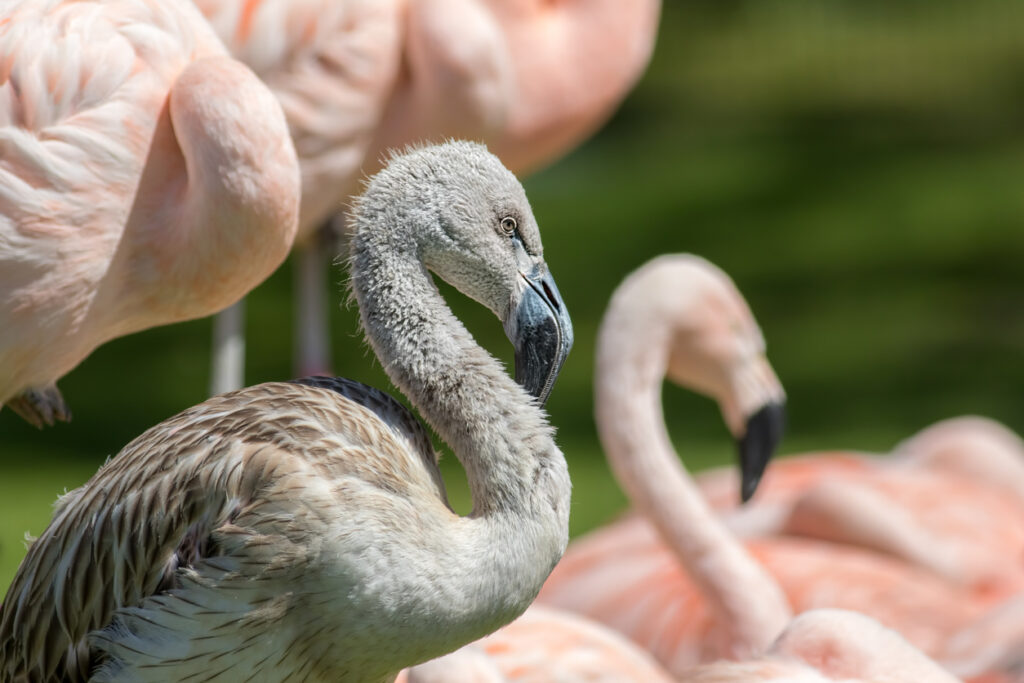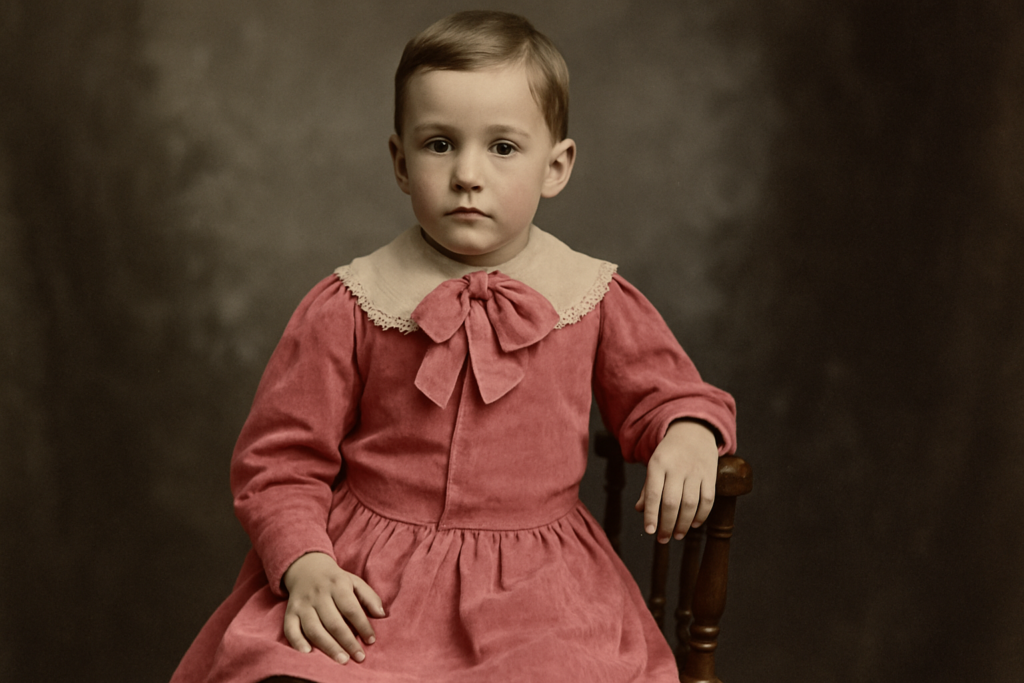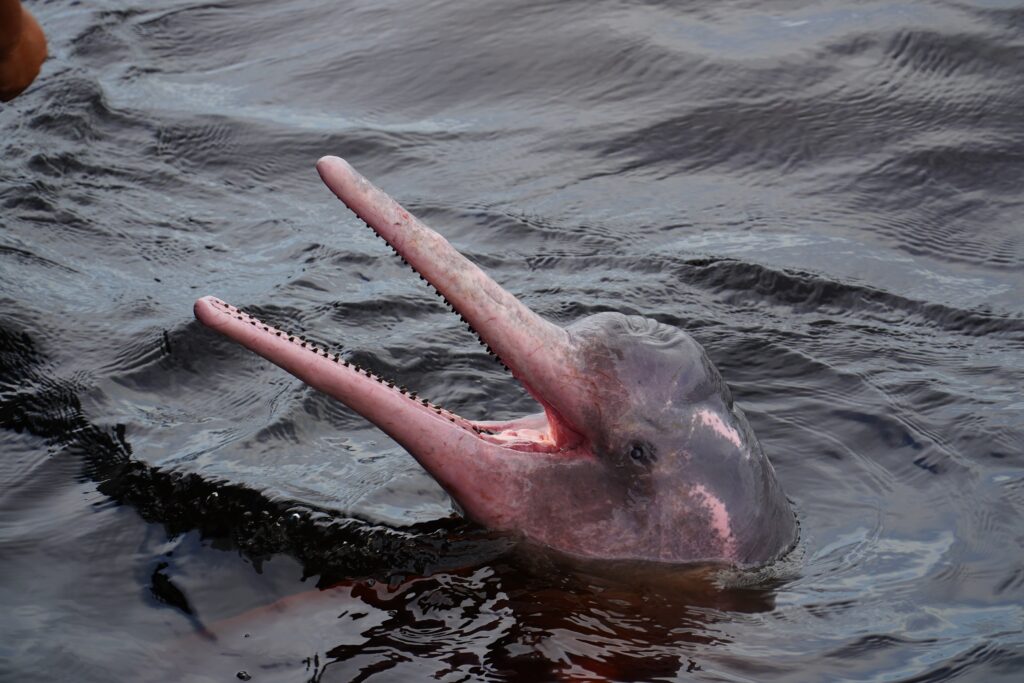1. Flamingos Aren’t Born Pink – They Eat Their Way Into the Color

Despite their iconic blush-colored feathers, flamingos start out gray. Their pink hue actually comes from carotenoid pigments in the algae and crustaceans they eat, specifically beta-carotene and canthaxanthin, which their bodies break down and deposit in their skin and feathers. The more shrimp-like zooplankton a flamingo consumes, the pinker it becomes. In captivity, birds often need pigment-rich food additives to maintain their color. Without it, they fade to a pale gray-white, a far cry from their tropical image.
The flamingo’s color isn’t just for looks; it’s a sign of health and desirability. In mating rituals, pink flamingos are statistically more likely to attract a mate because their vivid hue signals that they’re strong foragers with access to rich food sources. In short, flamingos have turned dinner into a display of status and strength, with their blush acting as both armor and attraction in the wild. Source: BBC Science Focus
2. Pink Was Once a Power Color—Especially for Boys

It may surprise modern readers, but pink was once considered the bolder, more masculine choice for young boys. In the early 20th century, department store catalogs often recommended pink for boys and blue for girls. The reasoning? Pink, being a lighter tint of red, was thought to be more assertive and more decisive, while blue was considered soft, dainty, and suited to girls. Even Franklin D. Roosevelt was famously photographed in a lacy pink outfit as a toddler in 1884, part of the era’s gender-neutral approach to infant fashion.
The color shift didn’t begin until the mid-1940s when marketing strategies and a post-war desire to reestablish traditional gender norms reassigned pink to femininity and blue to masculinity. Baby boom consumerism sealed the deal, with companies creating gendered clothing, toys, and even nursery décor. Today’s association of pink with girlhood is largely the result of decades of branding, not biology. Smithsonian Magazine
3. Seeing Pink Can Literally Calm Your Nervous System

There’s a reason pink is painted in prison cells, mental health facilities, and even locker rooms: it can reduce aggression, at least temporarily. In the late 1970s, researcher Alexander Schauss experimented with a specific shade he called Baker-Miller Pink (also known as “Drunk Tank Pink”) after noting that it seemed to have a tranquilizing effect on subjects. When this shade was painted in jail-holding cells in Seattle and San Bernardino, reports showed that inmates became noticeably calmer and less aggressive after just 15 minutes of exposure.
Follow-up studies have shown that while the effects are not permanent and may even reverse over time, the initial exposure to pink can lower heart rate, reduce muscle strength, and temporarily ease hostile behavior. This strange power of pink has intrigued psychologists for decades, sparking conversations about how color affects mood, stress levels, and even behavior in high-stakes environments. Source: Very Well Mind
4. Pink Isn’t on the Light Spectrum—It’s a Color Our Brain Invents

Unlike red, green, or blue, pink doesn’t exist as a single wavelength of light. It’s not technically in the visible spectrum at all. What we perceive as pink is a combination of red and violet light, which don’t sit next to each other on the spectrum. No wavelength corresponds to pink, so our brains fill in the gap, essentially inventing pink by blending long-wave red light with short-wave violet and interpreting it as a new color.
This makes pink a “non-spectral” color, something that exists only in our perception. To scientists, it’s a fascinating example of color as a neurological construct, not just a physical property of light. That might explain why pink feels more emotional or symbolic than strictly visual. It’s a color we think as much as we see, constructed by our brains to bridge the unbridgeable, and in doing so, it plays by its own rules. Source: Psychology Today
5. Some Cultures See Pink Very Differently

While pink is often associated with softness and femininity in the West, it carries radically different meanings elsewhere. In Japan, for instance, pink is associated not with women but with young men and samurai culture. The color evokes the fleeting beauty of cherry blossoms, sakura, which symbolizes both youthful vigor and the impermanence of life. That’s why pink is sometimes used in anime or advertising to suggest emotional depth, passion, or introspection rather than sweetness or innocence.
In India, pink is often associated with festivals and is considered a symbol of auspiciousness. Cities like Jaipur, nicknamed “The Pink City,” incorporate pink sandstone into their architecture to symbolize hospitality and grandeur. In Korea, the color was historically gender-neutral, while in Thailand, pink is associated with Tuesday and is worn on that day for good luck. These differences reveal how pink is more than a color; it’s a cultural canvas, capable of carrying dramatically different meanings depending on where and how it’s seen. Source: BBC Culture
6. The Pink Ribbon Wasn’t the First Symbol for Breast Cancer Awareness

The pink ribbon is now universally recognized as the symbol of breast cancer awareness, but it wasn’t the first attempt at raising visibility. The original awareness ribbon was peach, created in 1991 by activist Charlotte Haley, who was handing out peach-colored ribbons with cards urging the National Cancer Institute to increase funding for cancer prevention. When Estée Lauder and Self magazine approached her about using the ribbon for a campaign, Haley declined, worried about commercialization. In response, the companies changed the color to pink, and the rest is history.
Since then, the pink ribbon has become a global emblem for breast cancer awareness, research, and survivorship. It’s raised billions in funding, inspired October’s sea of pink product packaging, and even sparked critiques about “pinkwashing,” the use of breast cancer branding by companies without meaningful contribution. Still, for many survivors and families, the pink ribbon is more than a symbol; it’s a badge of hope, community, and resilience. Source: National Breast Cancer Org
7. Pink Animals Are Rarer Than You Think—And Often Temporary

In nature, true pink is a surprisingly rare color. While we have a few famous exceptions, flamingos, axolotls, and the occasional pink dolphin, most pink animals aren’t naturally pink at all. Instead, their coloring is influenced by factors such as diet, environment, or even lighting. The Amazon river dolphin, for instance, is born gray and turns pink with age due to scar tissue from fights and interactions with other dolphins. The more active (and scarred) the male, the pinker he appears, a badge of dominance.
Other pink creatures, like roseate spoonbills and particular species of starfish, get their coloring from carotenoid-rich diets, just like flamingos. There are also pink katydids and grasshoppers, but these are extremely rare and result from a genetic mutation called erythrism, similar to albinism but involving excess red pigments. These animals often stand out, and not in a good way. Their unusual hue can make them more visible to predators, proving that in the wild, being pretty in pink can come at a cost. Source: National Geographic
8. Pink Used to Be a Military and Political Color

Long before it adorned Barbie packaging, pink had a bold political edge. During World War II, the Nazis used a pink triangle to identify and persecute homosexual men in concentration camps. After the war, the LGBTQ+ community reclaimed the symbol in defiance and remembrance, transforming the pink triangle into a powerful emblem of pride and resistance. It remains one of the most poignant examples of color being redefined through activism.
In a very different arena, British military uniforms in the 18th and 19th centuries occasionally used “hunting pink,” a misnomer for a vivid red-pink hue worn during formal fox hunts or officer dress. Even into the 20th century, certain diplomatic corps and mess dress uniforms included bold pink sashes or linings, especially within the British Commonwealth. These historical uses of pink, far from dainty, demonstrate how the color once symbolized courage, authority, and protest, depending on who wore it and the context in which it was worn. Source: United States Holocaust Memorial Museum
9. Pink Food Often Isn’t Naturally Pink—It’s Engineered That Way

Do you think your strawberry yogurt or pink lemonade gets its color from fruit? Think again. Many pink foods owe their hue not to nature but to additives, some of which are surprising. For years, one of the most common sources of pink food dye was cochineal, a pigment derived from crushed insects, specifically, the female Dactylopius coccus, a tiny scale bug that feeds on prickly pear cactus. Cochineal extract, also called carmine or E120, produces a vivid pink-to-red tone used in everything from candy to Campari.
Although safe to consume, cochineal has caused a backlash among consumers who discovered its insect origins, prompting some brands to switch to plant-based alternatives, such as beet juice or anthocyanins from berries. Still, cochineal remains widely used, especially in products labeled “natural” rather than synthetic. So, if a label says “color added” but doesn’t specify the source, it might be a bug, as it treats its pretty pink pop. Source: FDA
10. Pink Noise May Help You Sleep Better Than White Noise

We’ve all heard of white noise, but pink noise is gaining attention for its powerful effects on sleep and memory. Unlike white noise, which spreads sound energy evenly across all frequencies, pink noise reduces higher frequencies, making it softer, deeper, and more natural, such as the sound of steady rain, wind through leaves, or ocean waves. The human ear finds it more pleasant and less harsh, especially over long periods.
Recent studies have shown that pink noise isn’t just soothing, it may improve deep sleep and even boost memory retention. A 2017 study from Northwestern University found that older adults who listened to timed bursts of pink noise during deep sleep had better memory recall the next day. The noise appears to enhance slow-wave sleep, the most restorative phase of the sleep cycle. So, while pink may be a calming color, it’s also a calming sound, one your brain may love even more while you rest. [Source: Journal of Frontiers in Human Neuroscience, Northwestern University]
11. Millennial Pink Wasn’t Just a Trend—It Was a Cultural Shift

Between 2012 and 2018, a muted, slightly dusty shade of pink took over everything from fashion runways to phone cases, branding campaigns, and Instagram feeds. Dubbed “Millennial Pink,” the color was hard to pin down; it hovered somewhere between blush, salmon, and beige. But its impact was clear: it marked a cultural rejection of hyper-gendered pink in favor of something more nuanced, ironic, and inclusive. Unlike the bubblegum pinks of the early 2000s, this version felt modern, androgynous, and emotionally intelligent.
Designers and marketers leaned into it hard. Brands like Glossier, Acne Studios, and Everlane embraced the shade as a way to signal softness without fragility and confidence without aggression. Critics have called it the defining color of a generation grappling with identity, wellness, and minimalism. Even Pantone took note, naming “Rose Quartz” its Color of the Year in 2016 alongside “Serenity,” a soft blue, intended as a statement on gender fluidity in design. Source: The Cut
12. Pink Sunsets Are Real—and They’re All About Particles

That jaw-dropping pink sky at sunset isn’t just for Instagram; it’s science in action. The rich pinks and magentas we see at dawn and dusk are caused by Rayleigh scattering, the same phenomenon that makes the sky appear blue during the day. As the sun lowers on the horizon, its light has to travel through more of Earth’s atmosphere. Along the way, shorter blue and violet wavelengths scatter out while the longer red and pink wavelengths make it through.
But there’s more: air quality, humidity, and even volcanic ash or wildfire smoke can deepen or shift the tones. Fine particles in the air enhance scattering, sometimes intensifying the pink or turning it neon. That’s why pink skies are often more vibrant in cities or after a storm. It’s also why sailors say, “Red sky at night, sailor’s delight; red sky in morning, sailor take warning.” Those colors can signal changes in weather patterns, not just pretty views. Source: Travel + Leisure
Final Takeaway: Pink Is Powerful

Pink isn’t just a color; it’s a conversation. It’s biology and branding, politics and psychology, tradition, and rebellion, from flamingos flaunting their meals to activists reclaiming symbols of oppression, pink shows up in ways that challenge our assumptions. It soothes prison inmates, inspires consumer trends, and lights up the sky at dusk. Whether it’s engineered into food coloring or crafted by our brains to bridge spectral gaps, pink is almost always doing more than meets the eye.
Its emotional charge is precisely what makes it timeless. Pink can comfort, provoke, soften, or shock, depending on how it’s used. It’s been worn by emperors and toddlers, weaponized by corporations, and reclaimed by movements. Ultimately, pink survives because it refuses to be pinned down; it bends, flexes, and reinvents itself again and again. In a world full of complex feelings, that might be the sweetest thing about it.
This article The Many Sweet Facts About the Color Pink was first published on dailyfetch.net.


